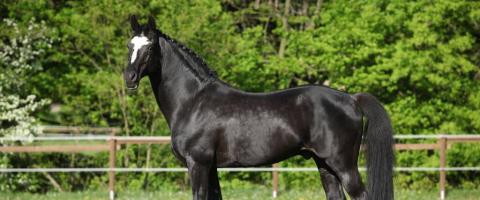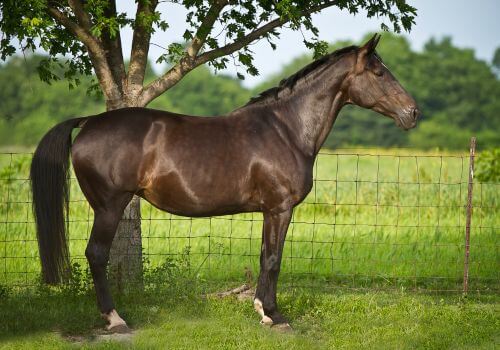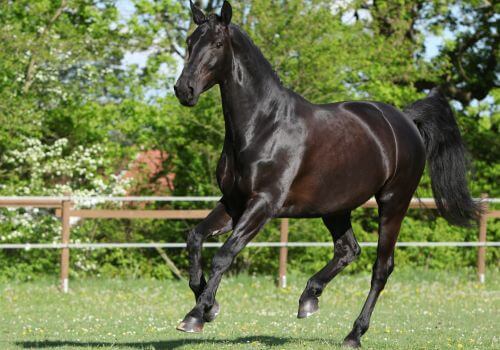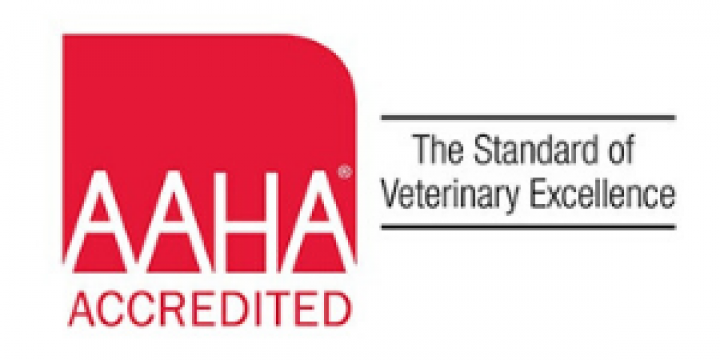
The Dutch Warmblood: Born to Compete!
- Weight: 1,430 pounds
- Height: 15 hands (60 inches) to 17 hands (68 inches)
- Body Type: Well-proportioned build; deep chest; muscular neck; powerful legs
- Best For: Riders and owners of all levels
- Life Expectancy: 20 years
A Horse with Royal Roots
The Dutch Warmblood horse traces its ancestry to the Netherlands before World War II. Originally, two native Dutch breeds — the Gelderlander, a stylish carriage and draft horse, and the Groningen, a heavier agricultural horse—formed the foundation of the modern Dutch Warmblood. As cars and tractors replaced horses, breeders shifted focus toward creating a versatile sport horse.
This selective breeding led to the Dutch Warmblood, a horse renowned for its strength, athleticism, and elegance. Today, these horses are registered with the Koninklijk Warmbloed Paardenstamboek Nederland (the Royal Warmblood Studbook of the Netherlands), ensuring that only the finest horses contribute to the breed’s future.

How Big is a Dutch Warmblood?
On average, Dutch Warmbloods stand between 15 and 17 hands tall and weigh around 1,430 pounds. To qualify as a breeding horse, mares must be at least 15.5 hands (62 inches), and stallions must be at least 15.75 hands (63 inches). While there is no upper height limit, extremely tall horses are less desirable for sport applications.
What Are Dutch Warmbloods Bred For?
Dutch Warmbloods are "warm-blooded" horses, meaning they have a balanced temperament — combining the power of "cold-blooded" draft horses with the athleticism and speed of "hot-blooded" breeds like Thoroughbreds and Arabians. Centuries of selective breeding have refined the Dutch Warmblood into an intelligent, powerful, and willing equine athlete.
Today, Dutch Warmbloods dominate in international show jumping and dressage, consistently ranking among the top competitors. They are also used in carriage driving and hunter competitions, where their graceful movements and strong conformation shine. Due to their even temperment, they make excellent recreational riding horses as well.
Dutch Warmblood Colors & Markings
Most Dutch Warmbloods are solid-colored, with black, bay, brown, gray, and chestnut being the most common. Many have white markings on their face and legs, and some may exhibit the tobiano (pinto) pattern, though it is less common.
Why Are Dutch Warmbloods So Special?
One of the most defining features of the Dutch Warmblood is its calm and cooperative temperament. Bred for ease of handling, these horses are known for their intelligence, willingness to learn, and ability to perform under pressure. Their combination of power, elegance, and adaptability makes them ideal for nearly any rider, from professional to amateur.
The Dutch Warmblood Diet
Like most performance horses, Dutch Warmbloods require a diet consisting of quality grass, hay, grains, and vitamin-rich supplements. Providing a well-balanced diet tailored to their workload ensures they maintain optimal health and performance.

Due to their size and activity level, some may require more feed than the average horse. Dutch Warmbloods are often considered easy keepers, meaning that they can gain weight easily if overfed and can become overweight without proper monitoring and portion control, so keeping a close eye on their body condition is strongly recommended.
Common Health Issues of Dutch Warmbloods
Dutch Warmbloods are generally healthy, thanks to strict breeding regulations that disqualify horses with congenital defects. However, they may still experience common equine health issues, such as:
- Arthritis: Due to their active careers, joint health must be closely monitored.
- Hoof and Leg Issues: Proper hoof care is essential to prevent lameness.
Breeding horses must pass rigorous health screenings, which helps maintain the breed’s overall health and longevity.
Grooming and Care of Your Dutch Warmblood
Regular grooming is essential for Dutch Warmbloods. Daily brushing removes dirt and distributes natural oils, while hoof inspections help prevent infections. Due to their active training schedules, routine vet checkups, farrier visits, and consistent care are absolutely necessary to help them to stay in peak condition.
Bringing It Back to the Barn
The Dutch Warmblood is one of the most versatile and successful sport horses in the world. With a blend of strength, agility, and a willing temperament, these horses continue to excel in competitive arenas and make exceptional partners for riders of all experience levels.

